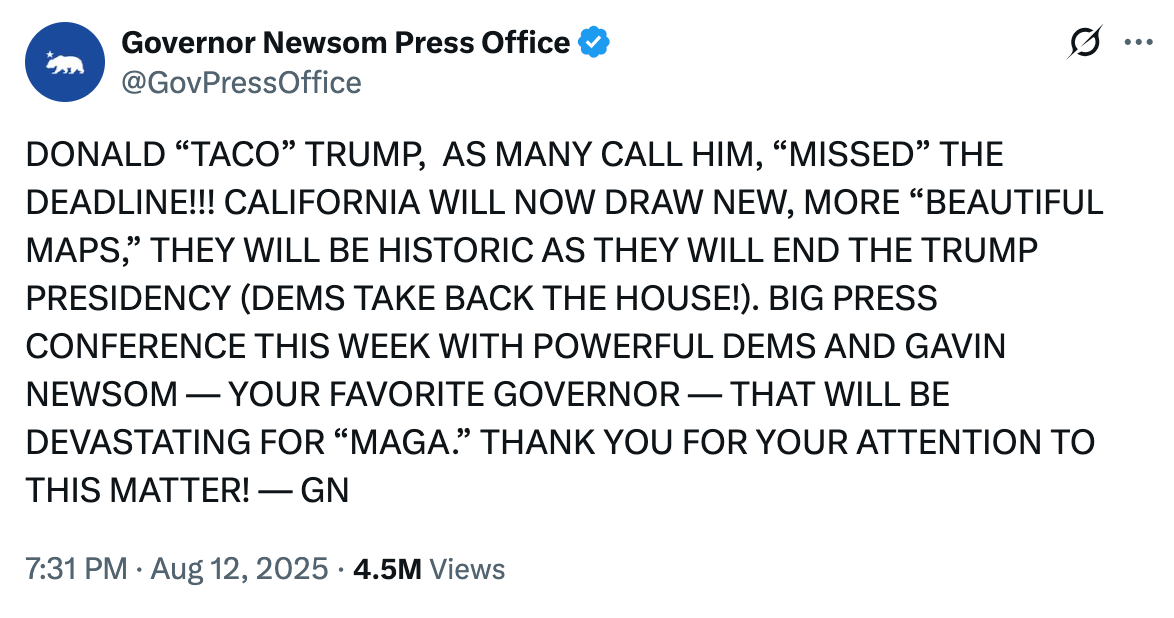 Photo: Tayfun Coskun/Anadolu/Getty Images
Photo: Tayfun Coskun/Anadolu/Getty Images
Congressional redistricting, which usually happens once every ten years, is one of those boring inside-baseball process issues that is hard to dramatize for politics-weary voters. When it happens off-schedule, as is occurring this year thanks to a power grab in Texas by Donald Trump and his Republican allies, it demands some special attention, which California governor Gavin Newsom is supplying by taunting Trump in the coin of his own realm with hyperbolic social-media posts like this one:

The backstory is that Newsom created a Tuesday “deadline” for Trump to call off the redistricting drive in Texas that is intended to generate a net gain of five U.S. House seats in 2026, lest California’s Democrats retaliate with their own new mid-decade congressional map offsetting the Texas changes entirely. Trump predictably ignored the challenge, and so now Newsom is issuing the final green light for a response. He has absolutely no time to waste.
For all the bully-boy bravado of Newsom’s insults to Trump, he has a significantly harder task than his rival in the White House. In Texas, drawing congressional maps is entirely the prerogative of a GOP-controlled legislature, and there’s precedent for a mid-decade recalibration of the districts. The only weapon Texas Democrats have to stop this partisan maneuver is to deny Republicans a quorum by fleeing the state, which is exactly what they have done in the face of proliferating threats that they’ll be arrested or expelled from the legislature. In California, however, voters amended the state constitution in 2008 to create an independent “citizens commission” to draw nonpartisan state-legislative districts and then extended it to congressional maps in 2010. So in order to carry out his threat to counter the Texas action, Newsom and California Democrats need a constitutional amendment to set aside the commission maps for the U.S. House and draw up a new blueprint that produces the necessary five-seat gain for their party. The legislature (in which Democrats have a supermajority) can place such an amendment on a statewide special-election ballot for November if it acts by August 22. The Hill explains the plan as it is emerging:
Newsom’s office has underscored the potential ballot measure would reaffirm California’s commitment to independent redistricting, while also allowing voters to “temporarily adjust” the congressional map for the next several cycles. But how the question will actually be formulated remains up in the air.
The measure is also expected to include “trigger” language, explaining how and who decides to move forward with redistricting in the Golden State if it happens in Texas or elsewhere.
Newsom’s gambit, which virtually every notable California Democrat is backing, with strong encouragement from national Democrats who fear their natural midterm advantage could be slipping away, depends on depicting this as a straightforward partisan knife fight with Donald Trump. The 47th president is at odds with California and its state and local governments on a broad array of issues, and his job-approval ratings among Golden State voters are deeply underwater (30 percent positive and 58 negative according to the most recent poll from Emerson) despite a relatively strong showing in 2024. Without this anti-Trump framing, it might be a heavy push to convince voters to return powers to politicians they took away over a decade ago. And aside from Republicans (particularly the five U.S. House incumbents whose districts would be tilted toward a solid Democratic majority in the proposed map), the maneuver will likely be opposed by good-government groups. It’s also likely to get pushback from former governor Arnold Schwarzenegger, who has long championed the nonpartisan system Newsom wants to suspend. Complicating the process is the short time frame for what will be an extremely expensive campaign in an off year when normally only local elections are held. California sends mail ballots to all registered voters about a month before every election.
Democratic legislators have been shown internal polling indicating the Newsom ballot initiative commands a 52 percent to 41 percent majority. The aforementioned Emerson survey also showed an advantage for Newsom, but with 42 percent of voters unsure. The governor’s strategy will likely echo the hyperpartisan message he used to defeat a recall effort in 2021 spurred by grievances over his handling of COVID-19 restrictions. And there’s no question his political future (he is term-limited next year, and is widely expected to run for president in 2028) is on the line with this vote.
It’s unclear how the war of the congressional maps will turn out nationally between now and 2026. Other states could undertake revisions of their own U.S. House districts. And overall, Republican states are more likely to have the sort of old-school systems that let legislators do whatever they want, rather than the more high-minded and complicated “independent commission” systems many blue states have adopted. Perhaps Democrats like Newsom will taunt Trump into overreaching on this front, and if nothing else, this year’s battles can give Democrats a head start toward the midterms campaign needed to wreck the Republican trifecta in Washington and put some real limits on Trump’s drive for power.
More on Politics
Newsom Launches Counterattack to Trump’s Texas Power GrabAre Texas Democrats Giving Up the Redistricting Fight?Why Texas Republicans Are So Eager to Lock Up Democrats
From Intelligencer - Daily News, Politics, Business, and Tech via this RSS feed

